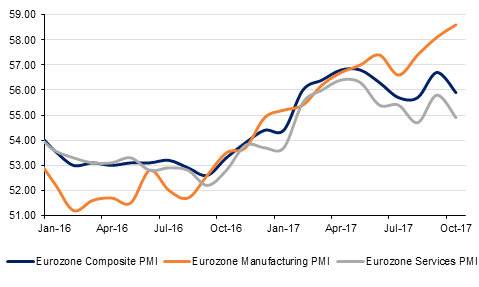
The key event in the region this week is Saudi Arabia’s Future Investment Initiative, which kicked off yesterday with an announcement of a new USD 500bn city and industrial zone on its borders with Egypt and Jordan. While details were sketchy, the city is expected to operate in similar way to the UAE’s freezones, with its own set of laws and regulations. Softbank Group’s Vision Fund has reportedly agreed to invest in the city and provide its (renewable) energy. The construction of the city is to be financed by the Saudi government, Public Investment Fund and private investors.
Separately, there were reports that Softbank’s Vision Fund is considering taking a ‘significant’ stake in Saudi Electricity. Partial privatization of state assets was one of the key goals of the Vision 2030 program, with the proceeds of asset sales reinvested to boost investment income for the budget and support economic diversification efforts in the Kingdom.
The Eurozone composite PMI declined to 54.9 in October on the back of a weaker services sector survey but still indicated a solid expansion at the start of Q4. The manufacturing PMI was better than forecast at 58.6, up from 58.1 in October. Perhaps more interesting from a monetary policy perspective, the survey pointed to rising inflationary pressures, with both input and output prices rising in October. US data was mixed, with the composite PMI rising in October to 55.7 while the Richmond Fed manufacturing index declined sharply to 12 from 19 in September.
There is a raft of data due today, starting with the German IFO Business Climate survey and a preliminary estimate of UK Q3 GDP, which is expected to remain unchanged at 0.3% q/q. Brexit secretary Davis is also due to speak this afternoon. In the US, the key data releases will be September durable goods orders and new home sales. The Bank of Canada is expected to keep rates on hold at 1.00% today.
 Source: Bloomberg, Emirates NBD Research
Source: Bloomberg, Emirates NBD Research
Yields on US treasuries were pushed higher overnight on increasing speculation about John Taylor leading the race to be the next Fed Chair. 2yr, 5yr, 10yr and 30yr UST yields closed at 1.58% (+2bps), 2.04% (+4bps), 2.42% (+5bps) and 2.93% (+5bps) respectively. Sovereign bonds in the Eurozone had little reason not to follow the UST move. Yields on 10yr Bunds closed up by 4bps to 0.47% and those on 10yr Gilts were also up by 4bps to 1.35%. Credit protection costs were unchanged with US IG and Euro Main CDS levels closing at 53bps and 55bps respectively.
Regional GCC bonds are surprisingly resilient in the face of large ongoing new supply. Yields on average Barclays GCC index closed at 3.43% (+2bps) and credit spreads unchanged at 128bps. Much in sync with stable oil prices, CDS levels on GCC sovereigns were range-bound with slight widening in Qatar (102bps) and Kuwait (63bps) but tightening in Dubai (124bps), Bahrain (238bps) and Saudi Arabia (83bps), albeit all with only 1bp to 2bps change.
Primary market is active with Apicorp, Adnoc and Mazoon Electricity in the market with benchmark sized offerings. Also on the wings are Qatar sovereign and few banks from Qatar.
AUD underperforms in the Asia session, coming under pressure after softer than expected economic data. Data from the Australian Bureau of Statistics showed that inflation in Q3 2017 slowed to 1.8% y/y from 1.9% the previous quarter, disappointing market expectations for an acceleration towards 2.0%. As we go to print, AUDUSD trades 0.75% lower at 0.77182. We expect some support to be found at the 200 day moving average (0.7694), however if this level is broken, a retest of 0.7643 (the 50% one year Fibonacci retracement) is likely to follow in quick succession.
US equities made another record, boosted by solid corporate result announcements. Dow Jones and S&P 500 closed up by +0.72% and +0.16% respectively. Shares across the Atlantic remained well supported with FTSE 100 (+0.03%) and DAX (+0.15%) closing in green. Asia also has opened with an upbeat mood with Nikkei and Hang Seng trailing up by +0.13% and +0.74% in early morning trades.
Increasing fear of capital outflow on the back of rising US rates is making international investors cautious on GCC equities. Equity bourses in the region continued to slide lower with the exception of Dubai index which was pushed higher by 0.64% due to gains in banking and property shares. Bahrain index lead the losses, closing down by -0.87% followed by Tadawul sliding by -0.66% despite oil remaining range bound and regulators in the country implementing measures to attract foreign investment in its listed corporates.
Oil markets got a loud and clear message from Saudi Arabia’s oil minister yesterday over the country’s determination to global inventories down. Khalid al Falih said Saudi Arabia was ‘flexible’ with regards to extending the current production cut to the end of 2018 or to consider other options. Falih also stressed there would not be a disorderly exit from the production cut deal as how to deal with a sudden uptick in production had not been considered when the deal was formed.
Brent futures closed up 1.7% and WTI futures gained 1.1% on the day. Curve structures remain unchanged, however, the backwardation in Brent is still compressing. The 1-2 month spread remains at less than USD 0.20/b while the contango in WTI widened to USD 0.20/b. Technical indicators look set to allow more gains for oil futures in the near term.